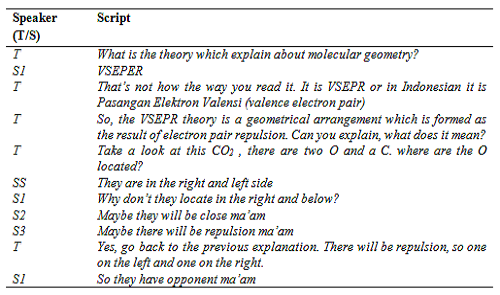
Identify Students’ Critical Thinking Skills During Chemistry Learning Process of Molecular Shapes
Abstract
Critical thinking skills become essential skills for students demanded by the 2013 curriculum. Effective learning critical thinking is very important for students in the classroom. This study aimed to identify students' critical thinking skills during chemistry learning process of molecular shapes. The method applied in this study was descriptive qualitative with a case study approach. It was conducted at one of high schools in Bandung were the participants were the tenth grade students’. The instruments used for data collection were audio, video and observation sheets. The collected data were analyzed using Transcript Based Lesson Analysis (TBLA). The results indicated that four out of twelve indicators of critical thinking skill had been identified in learning molecular shapes. The four indicators are formulating questions, answering the “why” questions, focusing on a question, judging the credibility of the sources, and interacting with others. The low achievement of critical thinking indicators was due to the method used in teaching which is still informative or transferring knowledge from teacher to student (teacher-centered) without giving sufficient time for students to reflect the material presented, link it with prior knowledge, or apply it in real life situations.
Keywords
Full Text:
PDFReferences
Arani, M. R. S. (2017). Raising the quality of teaching through kyouzai kenkyuu-the study of teaching materials. International Journal for Lesson and Learning Studies, 6(1), 10-26.
Brown, R. A. (2012). Music preferences and personality among Japanese university students. International Journal of Psychology, 47(2), 259-268.
Costa, A.L. & Presseisen, B.Z. (1985). Glossary of Thingking Skill, in A.L., Costa(ed). Developing Minds: A Resource Book for Teaching Thinking. Alexandria: ASCD.
Curran, E., Carlson, K., & Celotta, D.T. (2013). Changing attitudes and facilitating understanding in the undergraduate statistics classroom: A collaborative learning approach. Journal of the Scholarship of Teaching and Learning, 13(2), 49–71.
Ennis, R. H. (1985). Goals for a critical thinking curriculum; In Al Costa (ed). Developing minds : A resource book for teaching thinking. Alexandria : ASCD.
Farida, N. (2015). Analisis kesalahan siswa SMP kelas VIII dalam menyelesaikan masalah soal cerita matematika. AKSIOMA: Jurnal Program Studi Pendidikan Matematika, 4(2), 10-25.
Fuad, N.M. (2016). Improving Junior High Schools’ Critical Thinking Skills Based on Test Three Different Models of Learning. International Journal of Instruction. 10 (1), 101-116.
Fuad,.(2018). Profil Keterampilan Berpikir Kritis dan Kreatif
Siswa Serta Strategi Pembelajaran Yang Diterapkan Guru SMP di Kabupaten Kediri. Prosiding Seminar Nasional Biologi / Ipa dan Pembelajarannya. FMIPA: Universitas Negeri Malang.
Hassoubah, Z.I. (2002). Mengasah Pikiran Kreatif dan Kritis. Jakarta: Nuansa
Johnson, E.B. (2007). Contextual Teaching & Learning, Menjadikan Kegiatan Belajar-Mengajar Mengasyikkan dan Bermakna (Terjemahan Ibnu Setiawan). Bandung: MLC.
Jones, P., & Hammond, J. (2016). Talking to learn: Dialogic teaching in conversation with educational linguistics. Research Papers in Education, 31(1), 1–4.
Koksala. E. (2014). The Effect of Guided-Inquiry Instruction on 6th Grade Turkish Students’ Achievement, Science Process Skills, and Attitudes Toward Science. International Journal of Science Education, 36(1), 66–78.
Lailly, N. R., &Wisudawati, A. W. (2015).Analisis Soal Tipe Higher Order Thinking Skill (HOTS) dalam Soal UN Kimia SMA Rayon B Tahun 2012/2013. Jurnal Kaunia, 11(1), 27-39.
Nursiti,N.,&Barat,W.L.J. (2013). Keterampilan Berpikir Kritis (Critical Thinking Skill) dalam Pembelajaran Ilmu Pengetahuan Sosial. Jawa Barat: Widyaiswara LPMP
Sanjaya, & Wina. (2008). Perencanaan dan desain sistem pembelajaran. Jakarta: Kencana Prenada Media Group.
Sesen, B., & Tarhan, L. (2010). Promoting active learning in high school chemistry: Learning achievement and attitude. Procedia Social and Behavioral Sciences, 2(2), 2625–2630.
Sudarisman, S. (2015). Memahami Hakikat dan Karakteristik Pembelajaran Biologi dalam Upaya Menjawab Tantangan Abad 21 Serta Optimalisasi Implementasi Kurikulum 2013. Jurnal Florea, 2(1), 29–35
Trilling, B. & Fadel, C. (2009). 21st century skills Learning For Life In Our Times. San Francisco: Total Quality Management.
Walker, G. H. (2005). “Critical Thinking in Asynchronous Discussions.” International Journal of Instrucyional Technology and Distance Learning, 2(6),19-21.
DOI: http://dx.doi.org/10.31258/jes.4.4.p.890-900
Refbacks
- There are currently no refbacks.
Copyright (c) 2020 Arisna Oktavia Dijaya, Sumar Hendayana, Asep Supriatna

This work is licensed under a Creative Commons Attribution 4.0 International License.
Publisher: FKIP Universitas Riau












